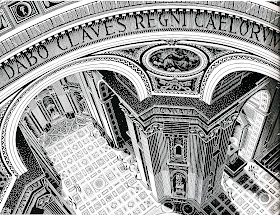Here are some of Escher’s block prints that I find especially noteworthy. (If you can find a book with good reproductions, it’s worth looking at them. The incredible precision of Escher’s work just can’t be appreciated in these poor small scans on a computer screen.)
St. Peter, Rome is a wood engraving done in 1935. No tricks, just insanely beautiful carving. Look at the angled sides of the pier in the center bottom of the piece. Notice how the slightest adjustment of width in the carved lines and the spaces between the carved lines creates the shading that defines the architecture. Dang, I want to carve like that! And if when you look at an engraving you can’t always tell whether you’re looking at a relief wood engraving or an intaglio copper engraving, here’s the clue. Notice that the grey of the floor has white lines criss-crossing over black. That tells you that the ink was printed by the uncarved part of the block. In an intaglio engraving you’ll see black lines criss-crossing white, because the ink prints from the incised lines.
Escher made the wood engraving Dragon in 1952. He said of it, “However much this dragon tries to be spatial, he remains completely flat… But this dragon is an obstinate beast, and in spite of his two dimensions he persists in assuming that he has three…” One of the things I find amazing about this piece is that the dragon really has no outline. This is especially noticeable along the bottom of his tail and stomach and the back of his leg. Escher has managed to make the creature’s outlines perfectly clear without ever actually carving them.
Development I is a woodcut from 1937. As a piece I don’t much like it, but as a sample of carving I find it utterly mind-boggling. Escher has made about ten different shades in a complete gradient from black to white, perfectly controlled, and all using only black and white, ink or no ink. (I know, unfortunately there are grayish areas in this scan. But that’s my fault, not Escher’s.)
Here’s another neat woodcut, from 1928. It’s called Tower of Babel, and once again demonstrates Escher’s mastery of the wood block. The level of detail just blows away anything I’ve ever accomplished. (It’s about 25 inches tall, bigger than any block I’ve ever attempted, too.)
For a few more of the many examples of Escher’s wood blocks, try googling “Dream,” “Sky and Water I,” “Stars,” “Butterflies,” “Double Planetoid” (a wood engraving printed from four blocks), or “Rippled Surface,” (a linoleum cut printed from two blocks.)
Finally I want to include Palm, from 1933. It’s a wood engraving made from two blocks. You can see most clearly how the grey block differs from the black block by looking at the downfolded leaf at the bottom left corner. I just love this one.
[Pictures: St. Peter, Rome, wood engraving by M.C. Escher, 1935;
Dragon, wood engraving by M.C. Escher, 1952;
Development I, woodcut by M.C. Escher, 1937;
Tower of Babel, woodcut by M.C. Escher, 1928;
Palm, wood engraving by M.C. Escher, 1933.
I scanned these pieces from M.C. Escher: The Graphic Work, Introduced and explained by the artist, Benedikt Taschen Verlag, 1992. (The reproductions in the book are copyright 1989.) My quotation from Escher also comes from this book, p 15. Many thanks to the publishers of this beautiful book!]






I comment whenever I like a article on a website or if I have
ReplyDeletesomething to valuable to contribute to the conversation. Usually it's caused by the sincerness communicated in the
article I browsed. And on this post "M.C. Escher's Wood Block Prints".
I was moved enough to drop a thought :-) I do have 2
questions for you if you usually do not mind. Is it just me
or do some of the responses appear like coming from brain dead folks?
:-P And, if you are writing at other social sites, I would like to keep
up with anything fresh you have to post. Would you
list every one of all your community pages like your linkedin profile, Facebook page or twitter feed?